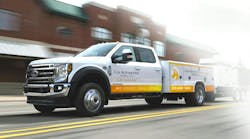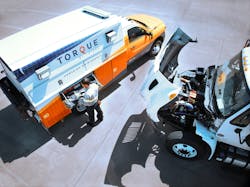More fleet maintenance providers consider mobile service
This is Part One of a two-part story. Read Part Two here.
When it comes to maintenance in 2024, fleets are more often demanding speed and convenience, leading to a steady rise in mobile operations.
“The realization that fleets do not have to establish fixed maintenance shops is driving the increase in demand,” explained Ted Coltrain, VP of operations, Fleet Services by Cox Automotive. He added that mobile techs coming on-site, as opposed to requiring an employee to drive the asset to a repair shop, is another major driver. Along with convenience, this all leads to better uptime, efficiency, and productivity as well. He also noted mobile technicians can supplement short-staffed in-house maintenance departments.
Those are some of the benefits, but any operation that wants to take the maintenance show on the road must also prepare for the challenges. A big one is managing employees responsible for both turning wrenches and steering wheels. Those who oversee a mobile maintenance division must also perform the role of fleet owner. To do both well, they will need to take a hard look at the latest technology and tools to help them multitask and keep up with evolving fleet technology.
If they don’t, they could be part of another big trend in the industry: getting bought out by larger, more tech-savvy outfits.
Scaling up
The industry was naturally headed toward more mobile maintenance before the COVID-19 lockdowns, and the trend has accelerated since then.
In 2018, large third-party providers including Ryder, TravelCenters of America, and FleetNet America had mobile trucks. Dickinson Fleet Services, which was founded in 1997, alone had 400 mobile service vehicles. At the beginning of 2021, Cox Automotive acquired Dickinson and folded the company into the Fleet Services unit. Coltrain, at the time an executive officer with Dickinson, came with the deal.
Fleet Services has doubled organically since then, with a current technician count of more than 1,500. Cox also added 195 mobile techs through mergers and acquisitions.
The transaction between Cox and Dickinson alerted everybody that mobile maintenance is a big industry,” said Joe Dougherty, CEO of Epika Fleet Services, who as COO of Dickinson in 2019 helped prepare them for sale.
Epika’s model is to acquire smaller maintenance operations, keep the owners on, and give them the capital, technological tools, and training to be able to scale and compete. The company comprises 10 different brands, with half in the shop and half mobile.
“We are approaching double in size this year, and we haven’t acquired a company—to give a perspective on organic growth,” Dougherty said.
Acquiring other mobile providers is “a no brainer, from a value proposition,” Dougherty said.
“If I’m a fleet owner and I can have a technician come to my facility and perform all the maintenance that can be done with a mobile service, I’m going to take that every day of the week, for a lot of reasons,” he continued.
This extends beyond dwell time and availability by helping fleets optimize labor utilization.
“[Fleet in-house shops] almost have to staff for the worst-case scenario when demand is the highest, so they’ve got underutilized labor,” Dougherty explained. “Mobile [from a] third-party service provider brings relief to that.”
Mobile is so ripe for growth that Ryder, which had 300 mobile trucks, started up a retail mobile fleet maintenance business unit called Torque (by Ryder) last summer. The service does not require a contract, with scheduling and payment handled online.
“The sale of convenience is becoming one of the greatest commodities,” noted Jordan Wagner, VP and GM of Torque. The business allows customers to not tie up employees by having them drive vehicles to and from dealerships or shops, he added. Services offered range from tires and brakes to suspensions and lighting.
“We don’t have really any restrictions on what we can do as long as we can figure out how to do it and do it safely,” Wagner said. “If given clearance, the techs can also work inside fleets’ facilities.”
Torque started with upfitted Ram 1500 trucks but has transitioned to Mercedes Sprinter vans. Wagner expected to have 160 units in operation this year, though finding and training technicians has limited their speed of growth.
Third-party providers aren’t the only ones going mobile. At the dealer level, Ford’s mobile service network now includes over 2,500 mobile service vans and Escapes pounding the pavement, the company reported. Specifically at Ford Pro, the Mobile Service unit has 800 certified technicians out on the road who can service brakes, lights, and tire rotations on multiple makes and models. They operate out of Ford Pro's 650+ commercial vehicle centers and new large-bay elite service centers.
“Mobile service is about maximizing the productive hours that a vehicle is out doing the job it was intended to do because every hour that fleet vehicle is down, it’s not just inconvenient—it’s lost revenue for the business,” said Travis Hunt, general manager, Ford Pro Parts and Service Transformation.
Having the shop come to you also allows your employees to focus on their primary role.
“You’re going to have to pay the driver using the fleet vehicle no matter what,” Hunt reasoned, “So, you’d rather that driver maximize their time doing their intended job by keeping your vehicle assets on the road, performing at a high level.”
Read more: Overachiever Awards: 'The Road Warrior' Ryan Ziegler
This was backed up at the service center level.
“[Ford Pro] Mobile Service, combined with an option for pick-up and delivery, has been a game-changer for our customers,” said Chris Gulbrandson, president of Apple Autos in Apple Valley, Minnesota, who opened the first Elite Service Center. “We can service multiple vehicles on one visit out to a customer’s workplace and potentially save them several hours of drive time and time spent having their employee wait or get picked up after dropping a vehicle. For our customers, a vehicle being down costs money, and having their own people transporting vehicles only multiplies that.”
Some companies rely on that convenience because they themselves sell speed. For example, Amazon has had Firestone Direct’s mobile vans, Sprinter and Ford Transits, come to the distribution center and perform light maintenance on several vans at once, according to Seth Hinton, Firestone Direct fleet analyst. Fleet demand is so great that the Bridgestone-owned business is approaching half B2B, half consumer. Services include oil and tire changes as well as brake work.
Hinton, a former fleet manager, noted how big it is not to have pay an employee an hourly wage for two hours waiting for a quick maintenance job to be done.
The technology challenge
National brands have the scale and resources to adopt the latest technology, something mom-and-pop shops looking to grow their mobile side cannot. This puts them at a major disadvantage, explained Epika’s Dougherty. While he helped prepare Dickinson Fleets for sale, with Epika, he is on the other side.
Epika is like a mobile co-op, using the larger network’s size and scale to provide the technology needed to compete in the space. These small providers may have the software to manage finances and inventory but not all the tools needed to diagnose and service modern trucks. If they can’t do that, the fleets are less likely to have them make a house call.
“It’s going to be difficult for fleets to embrace the growth mobile offers if the mobile service providers don’t step up the game and technology,” Dougherty said.
In Dougherty’s time working with small mobile providers, he’s gleaned that most have a basic system for financial reporting and inventory management, but they must go beyond basics to keep pace with the evolution of even fleets of 15-20 assets. Paper invoices with oily thumbprints on them won’t cut it when the fleets have gone digital. It’s also inefficient to have techs write info on paper and then re-enter data to a platform later.
He said fleets will wonder why they can afford to adopt new tech, but their maintenance provider can’t invest along with them. Dougherty answered that it’s because most are too small. He estimated 20,000 to 30,000 providers don’t use much, if any, technology.
“If the technology sophistication of the rest of the industry was like it is in maintenance right now, you would never get your package,” Dougherty quipped.
Along with sharing internally developed best practices, he revealed Epika is working on helping its acquisitions thrive with an under-development “killer app” for mobile maintenance that will help manage technicians and schedule work, something he says the sector desperately needs.
Coltrain noted some of the challenges include the difference in skill sets between shop and mobile technicians, along with the added complexity of managing resources like tools, parts, and equipment in a dynamic environment. Deploying these across a wide geographic area and managing a mobile workforce requires robust scheduling, communication, and performance tracking systems, Coltrain advised.
“Considering the challenges associated with mobile maintenance, the industry may see a combination of larger, established players expanding their mobile services and some consolidation among smaller providers,” Coltrain theorized. “The ability to overcome operational challenges and provide consistent, high-quality mobile maintenance services will likely be a key factor in determining success.”
Dougherty agreed.
“All mobile maintenance companies are technology companies,” he said. “The ones that don’t know that are soon to be acquisition targets.”
Wagner said Torque’s plan was to “grow organically but also to grow faster via acquisition,” adding that to scale faster, “maybe the easiest way to acquire techs and vehicles is to go purchase them.”
The choice for smaller operations now is if they should submit to acquisition or find a way to invest in themselves.
To read about the tools small mobile maintenance operations can invest in, see Part Two when it becomes available.





